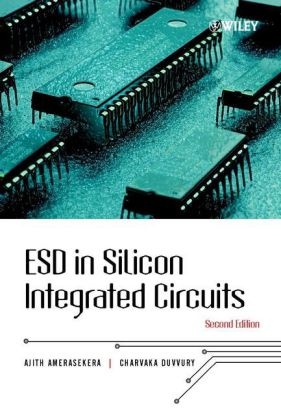Read more
Informationen zum Autor E. Ajith Amerasekera is the author of ESD in Silicon Integrated Circuits, 2nd Edition, published by Wiley. Charvaka Duvvury is the author of ESD in Silicon Integrated Circuits, 2nd Edition, published by Wiley. Klappentext Thema dieses Buches sind elektrostatische Entladungseffekte (ESD) in integrierten Siliciumschaltkreisen, die sich zu einem wesentlichen Problem der modernen hochintegrierten Schaltungen mit Strukturbreiten in Sub-Mikrometer-Dimensionen entwickelt haben. Diese 2. Auflage des klassischen Handbuchs liefert einen kompletten Überblick über alle Aspekte des ESD und die unmittelbaren Folgerungen für Entwurf und Entwicklung neuer Schaltkreise und Technologien. Die Hälfte des Materials wurde neu aufgenommen. das Autorenteam wurde um drei international anerkannte Experten erweitert. Zusammenfassung aeo Examines the various methods available for circuit protection, including coverage of the newly developed ESD circuit protection schemes for VLSI circuits. aeo Provides guidance on the implementation of circuit protection measures. aeo Includes new sections on ESD design rules, layout approaches, package effects, and circuit concepts. Inhaltsverzeichnis Preface 1. Introduction Background The ESD Problem Protecting against ESD Outline of the Book 2. ESD Phenomenon Introduction Electrostatic Voltage Discharge ESD Stress Models 3. Test Methods Introduction Human Body Model (HBM) Machine Model (MM) Charged Device Model (CDM) Socket Device Model (SDM) Metrology, Calibration, Verification Transmission Line Pulsing (TLP) Failure Criteria Summary 4 Physics and Operation of ESD Protection Circuits Introduction Resistors Diodes Transistor Operation Transistor Operation Under ESD Conditions Electrothermal Effects SCR Operation Conclusion 5 ESD Protection Design Concepts and Strategy The Qualities of Good ESD Protection ESD Protection Design Methods Selecting an ESD Strategy Summary 6 Design and Layout Requirements Introduction Thick Field Device NMOS Transistors (FPDs) Gate-Coupled NMOS (GCNMOS) Gate Driven nMOS (GDNMOS) SCR Protection Device ESD Protection Design Synthesis Total Input Protection ESD Protection Using Diode-Based Devices Power Supply Clamps BiPolar and BiCMOS Protection Circuits Summary 7 Advanced Protection Design Introduction PNP Driven NMOS (PDNMOS) Substrate Triggered NMOS (STNMOS) NMOS Triggered NMOS (NTNMOS) ESD for Mixed Voltage I/O CDM Protection SOI Technology High Voltage Transistors BiCMOS Protection RF Designs General I/O Protection Schemes Design/layout Errors Summary 8 Failure Modes, Reliability Issues, and Case Studies Introduction Failure Mode Analysis Reliability and Performance Considerations Advanced CMOS Input Protection Optimizing the Input Protection Scheme Designs for Special Applications Process Effects on Input Protection Design Total IC Chip Protection Power Bus Protection Internal Chip ESD Damage Stress Dependent ESD Behavior Failure Mode Case Studies Summary 9 Influence of Processing on ESD Introduction High Current Behavior Cross-section of a MOS Transistor Drain-Source Implant Effects P-Well Effects N-Well Effects Epitaxial Layers and Substrates Gate Oxides Silicides
List of contents
Preface
1. Introduction
Background
The ESD Problem
Protecting against ESD
Outline of the Book
2. ESD Phenomenon
Introduction
Electrostatic Voltage
Discharge
ESD Stress Models
3. Test Methods
Introduction
Human Body Model (HBM)
Machine Model (MM)
Charged Device Model (CDM)
Socket Device Model (SDM)
Metrology, Calibration, Verification
Transmission Line Pulsing (TLP)
Failure Criteria
Summary
4 Physics and Operation of ESD Protection Circuits
Introduction
Resistors
Diodes
Transistor Operation
Transistor Operation Under ESD Conditions
Electrothermal Effects
SCR Operation
Conclusion
5 ESD Protection Design Concepts and Strategy
The Qualities of Good ESD Protection
ESD Protection Design Methods
Selecting an ESD Strategy
Summary
6 Design and Layout Requirements
Introduction
Thick Field Device
NMOS Transistors (FPDs)
Gate-Coupled NMOS (GCNMOS)
Gate Driven nMOS (GDNMOS)
SCR Protection Device
ESD Protection Design Synthesis
Total Input Protection
ESD Protection Using Diode-Based Devices
Power Supply Clamps
BiPolar and BiCMOS Protection Circuits
Summary
7 Advanced Protection Design
Introduction
PNP Driven NMOS (PDNMOS)
Substrate Triggered NMOS (STNMOS)
NMOS Triggered NMOS (NTNMOS)
ESD for Mixed Voltage I/O
CDM Protection
SOI Technology
High Voltage Transistors
BiCMOS Protection
RF Designs
General I/O Protection Schemes
Design/layout Errors
Summary
8 Failure Modes, Reliability Issues, and Case Studies
Introduction
Failure Mode Analysis
Reliability and Performance Considerations
Advanced CMOS Input Protection
Optimizing the Input Protection Scheme
Designs for Special Applications
Process Effects on Input Protection Design
Total IC Chip Protection
Power Bus Protection
Internal Chip ESD Damage
Stress Dependent ESD Behavior
Failure Mode Case Studies
Summary
9 Influence of Processing on ESD
Introduction
High Current Behavior
Cross-section of a MOS Transistor
Drain-Source Implant Effects
P-Well Effects
N-Well Effects
Epitaxial Layers and Substrates
Gate Oxides
Silicides
Contacts
Interconnect and Metallization
Gate Length Dependencies
Silicon-On-Insulator (SOI)
Bipolar Transistors
Diodes
Resistors
Reliability Trade-Offs
Summary
10 Device Modeling of High Current Effects
Introduction
The Physics of ESD Damage
Thermal ("Second") Breakdown
Analytical Models Using the Heat Equation
Electrothermal Device Simulations
Conclusions
Circuit Simulation Basics, Approaches, and Simulations
Introduction
Modeling the MOSFET
Modeling Bipolar Junction Transistors
Modeling Diffusion Resistors
Modeling Protection Diodes
Simulation of Protection Circuits
Electrothermal Circui

